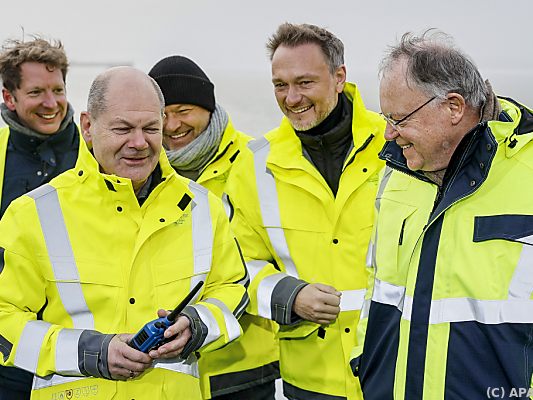
Schulz with his ministers
© APA / AFP
German Chancellor Olaf Scholz inaugurated Germany’s first LNG terminal in Wilhelmshaven. “By the end of next year we will probably have an import capacity of more than 30 billion cubic meters of gas,” Schultz said Saturday in Wilhelmshaven at the inauguration of the first floating LNG terminal. “This is the new pace in Germany,” he added, referring to the fast construction time.
The opening ceremony was also attended by Economy Minister Robert Habeck (Green), Finance Minister Christian Lindner (FDP) and Prime Minister of Lower Saxony Stefan Weil (SPD). The floating terminal off the North Sea coast in Lower Saxony is intended to help fill a gas supply gap in Germany caused by a shortage of shipments from Russia.
Shortly before the opening of the first floating LNG terminal on the German North Sea coast, Scholz and the Norwegian company Hoyg confirmed that they would quickly take an interest in expanding their liquid gas connections. “Our goal is to fully compensate for the loss of Russian gas next year,” Schultz told the Sueddeutsche Zeitung newspaper.
You can also bypass the next winter. “We can assume that, as this year, if nothing unexpected happens. We should continue to push ahead with building new LNG terminals next year – and also conclude more supply contracts in the future,” said Schulz.
The German Federal Government is in constant contact with gas importers and also promotes the conclusion of long-term contracts. “As a lesson from the past, we must make ourselves less dependent on individual suppliers in the future,” Schultz warned. Most of the gas will come from Norway, the United States and the Gulf, and a small part from the Netherlands.
Energy company Uniper recently announced that the “Höegh Esperanza” being loaded in Spain has about 165,000 cubic meters of LNG on board. This corresponds to about 96 million cubic meters of natural gas and could supply between 50,000 and 80,000 households for a year. A total of five of these floating facilities have been chartered by the German federal government. Each must have at least five billion cubic meters per year – just over five percent of Germany’s annual consumption.
The Norwegian company Höegh LNG claims that it is negotiating with several European countries about the delivery of more floating liquid gas terminals. Eric Neheim, head of the group, told Reuters news agency that discussions would take place on state-sponsored projects as well as on commercial projects. He did not mention the names of the countries. His group has already promised Europe half of Höegh’s fleet of private vessels – a fifth of the so-called floating storage and reconversion units (FSRU). They will provide between 25 and 35 billion cubic meters of gas next year.

“Food practitioner. Bacon guru. Infuriatingly humble zombie enthusiast. Total student.”








More Stories
Kyiv: Russian Kursk offensive halted
US Presidential Election: Former US Government Officials Warn Against Donald Trump's Election
Netherlands wants to leave asylum system